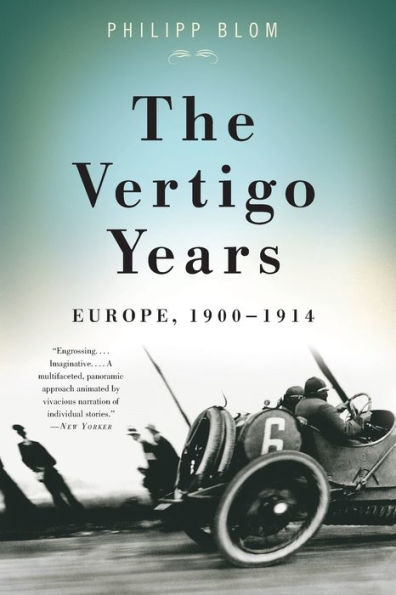

Paperback(First Trade Paper Edition)
-
PICK UP IN STORECheck Availability at Nearby Stores
Available within 2 business hours
Related collections and offers
Overview
In this short span of time, a new world order was emerging in ultimately tragic contradiction to the old. These were the years in which the political and personal repercussions of the Industrial Revolution were felt worldwide: Cities grew like never before as people fled the countryside and their traditional identities; science created new possibilities as well as nightmares; education changed the outlook of millions of people; mass-produced items transformed daily life; industrial laborers demanded a share of political power; and women sought to change their place in society — as well as the very fabric of sexual relations.
From the tremendous hope for a new century embodied in the 1900 World's Fair in Paris to the shattering assassination of a Habsburg archduke in Sarajevo in 1914, historian Philipp Blom chronicles this extraordinary epoch year by year. Prime Ministers and peasants, anarchists and actresses, scientists and psychopaths intermingle on the stage of a new century in this portrait of an opulent, unstable age on the brink of disaster.
Beautifully written and replete with deftly told anecdotes, The Vertigo Years brings the wonders, horrors, and fears of the early twentieth century vividly to life.

Product Details
| ISBN-13: | 9780465020294 |
|---|---|
| Publisher: | Basic Books |
| Publication date: | 11/02/2010 |
| Edition description: | First Trade Paper Edition |
| Pages: | 488 |
| Product dimensions: | 5.80(w) x 8.90(h) x 1.30(d) |
| Age Range: | 13 - 18 Years |
About the Author
Read an Excerpt
Introduction
Today, the period before the outbreak of the First World War is often regarded as idyllic: the time before the fall, the good old days, a belle époque celebrated in lavishly decorated films, a beautiful, intact society about to be shattered by the forces driving it inexorably towards disaster. After 1918, ‘lower’ classes and the peoples in the colonies were rapidly outbreeding ‘civilized’ whites. We hear echoes of this debate today in the hysterical polemics about birth rates among Muslim immigrants to Europe, much debated forecasts about the growth of the world’s population, and the decline of numbers in Europe and the USA, not to mention biological research indicating the decline of fertility among Western men.
Speed and exhilaration, anxiety and vertigo were recurrent themes of the years between 1900 and 1914, during which cities exploded in size and societies were transformed, mass production seized hold of everyday life, newspapers turned into media empires, cinema audiences were in the tens of millions, and globalization brought meat from New Zealand and grain from Canada to British dinner plates, decimating the incomes of the old landed classes and enabling the rise of new kinds of people: engineers, technocrats, city-dwellers. Modernity did not rise virgin-born from the trenches of the Somme. Well before 1914, it had already taken a firm hold on the minds and lives of Europe. The War acted not as a creator, but as a catalyst, forcing old structures to collapse more quickly and new identities to assert themselves more readily.
The Vertigo Years had much in common with our own day, notleast their openness: in 1910 and even in 1914, nobody felt confident of the shape the future world would have, of who would wield power, what political constellation would be victorious, or what kind of society would emerge from the headlong transformation. By contrast, during the second half of the twentieth century the Cold War created a quite different situation: the outcome seemed uncertain, but it was perfectly clear what was at stake, and equally clear that one of two ideological systems would eventually be victorious. With the collapse of the Soviet empire, some of the openness and uncertainty of the Vertigo Years have reappeared, and today it is much more difficult to say what the future will bring for our societies.
In a large part, the uncertain future facing us early in the twenty-first century arose from the inventions, thoughts and transformations of those unusually rich fifteen years between 1900 and 1914, a period of extraordinary creativity in the arts and sciences, of enormous change in society and in the very image people had of themselves. Everything that was to become important during the twentieth century — from quantum physics to women’s emancipation, from abstract art to space travel, from communism and fascism to the consumer society, from industrialized slaughter to the power of the media — had already made deep impressions in the years before 1914, so that the rest of the century was little more than an exercise, wonderful and hideous by turn, in living out and exploring these new possibilities.
From the Hardcover edition.
Table of Contents
List of Illustrations viii
Acknowledgements xi
Introduction 1
1 1900: The Dynamo and the Virgin 5
2 1901: The Changing of the Guard 23
3 1902: Oedipus Rex 44
4 1903: A Strange Luminescence 71
5 1904: His Majesty and Mister Morel 92
6 1905: In All Fury 122
7 1906: Dreadnought and Anxiety 155
8 1907: Dreams and Visions 189
9 1908: Ladies with Rocks 219
10 1909: The Cult of the Fast Machine 249
11 1910: Human Nature Changed 277
12 1911: People's Palaces 308
13 1912: Questions of Breeding 334
14 1913: Wagner's Crime 360
15 1914: Murder Most Foul 388
Notes 409
Bibliography 426
Index 453
